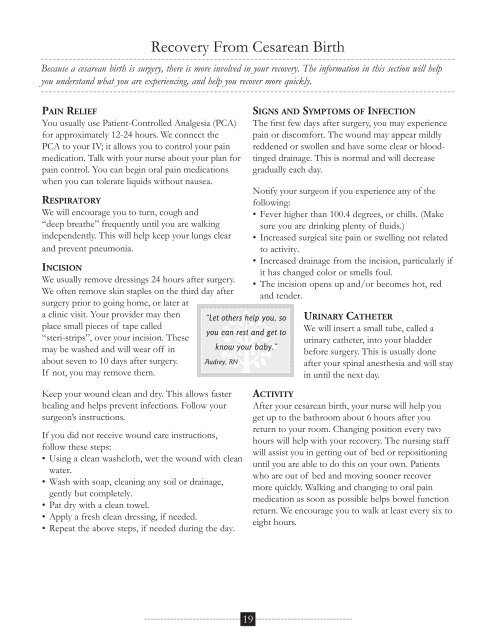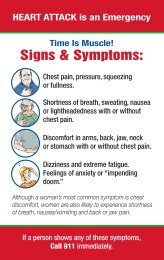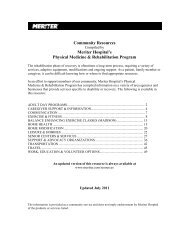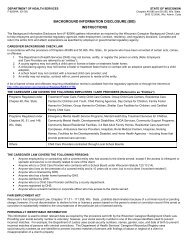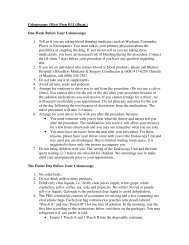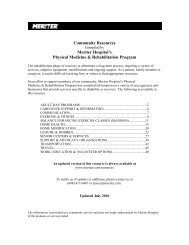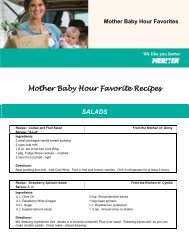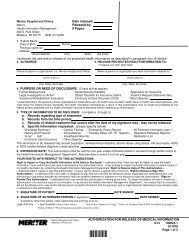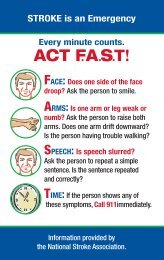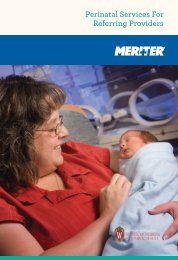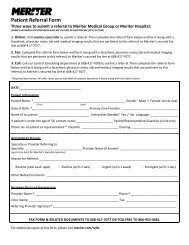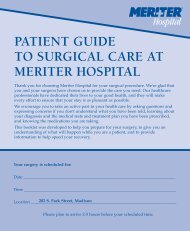A Guide To Your New Family's First Weeks - Meriter Health Services
A Guide To Your New Family's First Weeks - Meriter Health Services
A Guide To Your New Family's First Weeks - Meriter Health Services
Create successful ePaper yourself
Turn your PDF publications into a flip-book with our unique Google optimized e-Paper software.
Recovery From Cesarean Birth<br />
Because a cesarean birth is surgery, there is more involved in your recovery. The information in this section will help<br />
you understand what you are experiencing, and help you recover more quickly.<br />
Pain Relief<br />
You usually use Patient-Controlled Analgesia (PCA)<br />
for approximately 12-24 hours. We connect the<br />
PCA to your IV; it allows you to control your pain<br />
medication. Talk with your nurse about your plan for<br />
pain control. You can begin oral pain medications<br />
when you can tolerate liquids without nausea.<br />
Respiratory<br />
We will encourage you to turn, cough and<br />
“deep breathe” frequently until you are walking<br />
independently. This will help keep your lungs clear<br />
and prevent pneumonia.<br />
Incision<br />
We usually remove dressings 24 hours after surgery.<br />
We often remove skin staples on the third day after<br />
surgery prior to going home, or later at<br />
a clinic visit. <strong>Your</strong> provider may then<br />
place small pieces of tape called<br />
“steri-strips”, over your incision. These<br />
may be washed and will wear off in<br />
about seven to 10 days after surgery.<br />
If not, you may remove them.<br />
“Let others help you, so<br />
you can rest and get to<br />
know your baby.”<br />
Audrey, RN<br />
Signs and Symptoms of Infection<br />
The first few days after surgery, you may experience<br />
pain or discomfort. The wound may appear mildly<br />
reddened or swollen and have some clear or bloodtinged<br />
drainage. This is normal and will decrease<br />
gradually each day.<br />
Notify your surgeon if you experience any of the<br />
following:<br />
• Fever higher than 100.4 degrees, or chills. (Make<br />
sure you are drinking plenty of fluids.)<br />
• Increased surgical site pain or swelling not related<br />
to activity.<br />
• Increased drainage from the incision, particularly if<br />
it has changed color or smells foul.<br />
• The incision opens up and/or becomes hot, red<br />
and tender.<br />
Urinary Catheter<br />
We will insert a small tube, called a<br />
urinary catheter, into your bladder<br />
before surgery. This is usually done<br />
after your spinal anesthesia and will stay<br />
in until the next day.<br />
Keep your wound clean and dry. This allows faster<br />
healing and helps prevent infections. Follow your<br />
surgeon’s instructions.<br />
If you did not receive wound care instructions,<br />
follow these steps:<br />
• Using a clean washcloth, wet the wound with clean<br />
water.<br />
• Wash with soap, cleaning any soil or drainage,<br />
gently but completely.<br />
• Pat dry with a clean towel.<br />
• Apply a fresh clean dressing, if needed.<br />
• Repeat the above steps, if needed during the day.<br />
Activity<br />
After your cesarean birth, your nurse will help you<br />
get up to the bathroom about 6 hours after you<br />
return to your room. Changing position every two<br />
hours will help with your recovery. The nursing staff<br />
will assist you in getting out of bed or repositioning<br />
until you are able to do this on your own. Patients<br />
who are out of bed and moving sooner recover<br />
more quickly. Walking and changing to oral pain<br />
medication as soon as possible helps bowel function<br />
return. We encourage you to walk at least every six to<br />
eight hours.<br />
19


